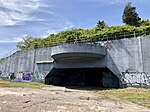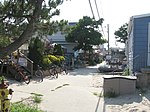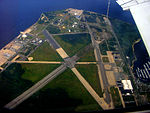Jacob Riis Park

Jacob Riis Park, also called Jacob A. Riis Park and Riis Park, is a seaside park on the southwestern portion of the Rockaway Peninsula in the New York City borough of Queens. It lies at the foot of the Marine Parkway–Gil Hodges Memorial Bridge, east of Fort Tilden, and west of Neponsit and Rockaway Beach. Originally run by the New York City Department of Parks and Recreation, it is now part of the Jamaica Bay Unit of the Gateway National Recreation Area, and is managed by the National Park Service (NPS). It features an extensive sand beach along the Atlantic Ocean coastline and several historic Art Deco structures. In 1912, the city, urged on by social journalist Jacob Riis, acquired the land for a park initially called Seaside Park and later Telawana Park. In 1914, the park was renamed for Riis. During World War I, the site was used as the Rockaway Naval Air Station, one of the first naval air stations in the United States and, in 1919, the launching point for the first transatlantic flight. The signature bathhouse was built in 1932, but much of the park's infrastructure and approaches were built between 1936 and 1937 by New York City Parks Commissioner Robert Moses, who envisioned it as a getaway for New York City residents, like Jones Beach State Park further east on Long Island. The park was built along with the Marine Parkway Bridge and the Belt Parkway in nearby Brooklyn, which provided access to the park. After a period of decline, Jacob Riis Park was transferred in 1974 to the control of the National Park Service. The Jacob Riis Park Historic District was listed on the National Register of Historic Places in 1981.
Excerpt from the Wikipedia article Jacob Riis Park (License: CC BY-SA 3.0, Authors, Images).Jacob Riis Park
Beach Channel Drive Greenway, New York Queens
Geographical coordinates (GPS) Address External links Nearby Places Show on map
Geographical coordinates (GPS)
| Latitude | Longitude |
|---|---|
| N 40.5675 ° | E -73.873333333333 ° |
Address
Jacob Riis Park Historic District
Beach Channel Drive Greenway
11694 New York, Queens
New York, United States
Open on Google Maps








